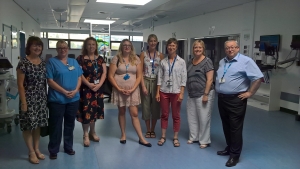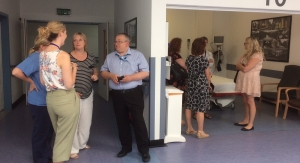With the Butterfly Scheme stretching across the UK and Ireland, there’s quite a network out there! This offers some excellent opportunities for teams wanting to further enhance their dementia care; other teams with relevant experience are keen to act as guides.
When I heard that the Betsi Cadwaladr team wanted to look at enhancing dementia care in ED / A & E, I immediately thought of the Airedale Hospital team, whose new-build ED had allowed them to design with dementia care in mind. Both teams were keen for the link to be made – and, after early discussion by phone, a visit from North Wales to West Yorkshire was planned. It was a real pleasure to be part of that day (despite it being one of the hottest days of the year!) when, happily, learning took place not just for one team, but for both – including hearing about Lynda at Betsi Cadwaladr’s insight sessions for care home teams, partly so that they understood the A & E experience for their residents; as Lynda so neatly put it, “A & E is not a ward!”.
Whilst dementia-friendly design is ideal – and Airedale consultant in emergency medicine, Meg, was able to describe that whole process to the Betsi team – so much can also be done by working in a dementia-friendly way with the surroundings you’ve got. Effective tweaks can be made without spending a fortune, whilst huge improvements can be made by thinking through what really increases or decreases stress in ED, not only for the patient, but for any accompanying carer. My own mother’s greatest challenge in ED, for example, was the constant beeping of machines; every thirty seconds, she’d ask me anxiously what that noise was. There are so many things that could be done to either remove or distract from those beeps, making a huge difference not only to people like Mum – but also to the carer, who can’t control the situation; that inability to remove the source of anxiety can allow stress to build up enormously, especially when added to the concern over the patient’s health.
Of course, whilst some issues will be common to many people affected by dementia, each individual will have their own triggers and relievers of stress. The range of safe waiting areas at Airedale allows for that person-centred approach, but it’s not possible for all hospitals to provide that. The person who usually cares for the patient is hugely valuable in supporting them through ED, not only by offering reassurance and distraction, but also by providing staff with information that might not be reliably available from the patient themselves. At Airedale that day, a lady who had come in from a care home was accompanied by a younger lady. I asked the younger lady whether she was the patient’s daughter. “No,” she replied, “only a carer.” Only? ONLY? I assure you that a discussion followed and that carer has promised never again to describe herself as “only a carer”! Whilst the Airedale team offered wonderful care, that carer really did make a positive difference to all.
So, great collaboration! As I’ve so often said, teamwork is key; if we all work together, we can keep making dementia care better and better.



